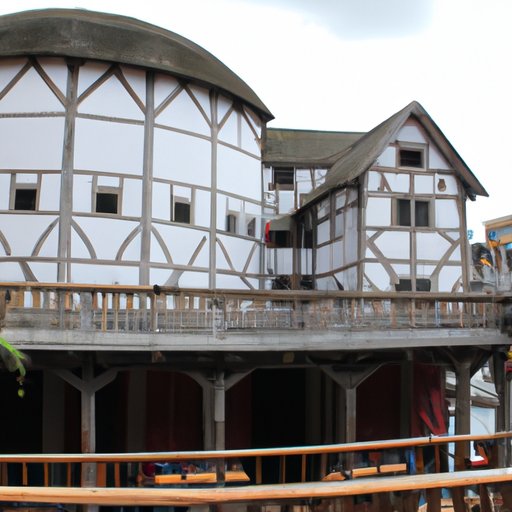Introduction
The Globe Theatre is one of the most iconic theatres in history. Constructed in 1599, it served as a venue for William Shakespeare’s plays and other performances. Over the centuries, the Globe Theatre has become synonymous with traditional theatre, as well as with some of the most famous works of literature ever written. In this article, we will explore the history of the Globe Theatre, from its origins and architectural structure to its lasting legacy.
Historical Overview
The Globe Theatre was built in 1599 by Richard Burbage, a successful actor and entrepreneur. The theatre was located south of the Thames River in London, England. It was part of the Bankside entertainment district, which included other prominent theatres such as the Rose and Swan. The Globe Theatre was destroyed by fire in 1613, but it was rebuilt and reopened the following year. The theatre remained in operation until 1642, when it was closed due to religious restrictions imposed by the Puritans.
Throughout its history, the Globe Theatre hosted some of the most renowned performances of the time. During its first season, the theatre showcased William Shakespeare’s Henry V and Julius Caesar. Other notable plays that were performed at the Globe Theatre include Hamlet, Macbeth, and Othello. These plays helped make the theatre a popular destination for theatregoers.
Architecture and Design
The Globe Theatre was designed with several distinct features. The building was round in shape and made of wood and plaster. It had three levels, with the uppermost level known as the “lords’ rooms.” The stage was open to the sky, allowing natural light to enter the theatre. The theatre also had two balconies, where spectators could watch the performances from a higher vantage point.
The Globe Theatre also featured a trapdoor, which was used for dramatic entrances or exits. It was surrounded by an outdoor courtyard, which allowed spectators to stand and watch the performances from outside the building. This feature was especially popular among those who could not afford the expensive tickets for the indoor seating.
Audience Experience
The atmosphere of the Globe Theatre was lively and energetic. Spectators often cheered and booed during performances, creating a sense of excitement and anticipation. Performances were usually accompanied by music, and actors often interacted directly with the audience. This made for an immersive experience for the spectators, who felt like they were part of the performance.
The Globe Theatre was also known for its elaborate costumes and sets. These features helped to create an immersive world for the audience, transporting them to a different time and place. The theatre also featured special effects, such as thunder and lightning, which added to the drama of the performance.
Plays and Performances
The Globe Theatre was home to some of the most famous plays in history. William Shakespeare’s plays were particularly popular at the theatre. His works included tragicomedies such as Romeo and Juliet and comedies such as A Midsummer Night’s Dream. These plays were known for their complex characters, intricate storylines, and poetic language. They often featured themes of love, tragedy, and redemption, making them appealing to audiences of all ages.
The performances at the Globe Theatre had a lasting impact on theatre and literature. Shakespeare’s plays have been adapted for stage, film, and television, and his works are still studied and performed around the world. The Globe Theatre also served as an inspiration for many later theatres, including the reconstructed Globe Theatre that stands today in London.
Legacy
The Globe Theatre has left a lasting mark on theatre and culture. Its influence can be seen in modern theatre, from the use of natural lighting to the emphasis on character development. The Globe Theatre was also responsible for popularizing certain theatrical conventions, such as the use of soliloquies and asides. These conventions are still used in theatre today.
The Globe Theatre has also achieved a level of fame that few other theatres have attained. It is mentioned in countless books, films, and TV shows, and it continues to inspire people around the world. Many people visit the reconstructed Globe Theatre each year to learn more about its history and legacy.
What We Can Learn
From the Globe Theatre, we can learn a great deal about the importance of traditional theatre techniques. By studying the theatre’s design and performance style, we can gain insight into how to create an engaging performance. We can also appreciate the power of storytelling and the impact it can have on audiences.
Impact on Modern Theatre
The Globe Theatre has had a profound impact on modern theatre. Its influence can be seen in the use of natural lighting, the focus on character development, and the incorporation of soliloquies and asides. The Globe Theatre also inspired the creation of many other theatres, such as the Royal Shakespeare Company in London.
In addition, the Globe Theatre has helped to popularize certain plays and genres. Shakespeare’s works, in particular, continue to be widely studied and performed. This demonstrates the lasting influence of the Globe Theatre on theatre and culture.
Conclusion
The Globe Theatre is one of the most significant and influential theatres in history. Its origins date back to 1599, and it has since become a symbol of traditional theatre. From its architecture and design to its performances, the Globe Theatre has left an indelible mark on theatre and culture. It serves as an example of how theatre can engage and entertain audiences, as well as how it can leave a lasting impression.
(Note: Is this article not meeting your expectations? Do you have knowledge or insights to share? Unlock new opportunities and expand your reach by joining our authors team. Click Registration to join us and share your expertise with our readers.)
